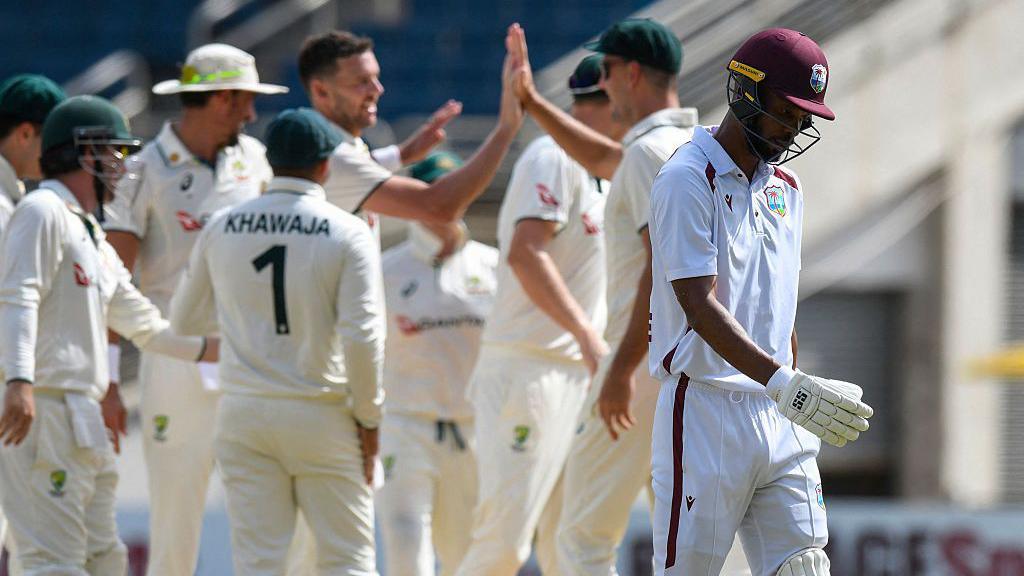The West Indies cricket team recently found themselves in an unfortunate historical predicament as they were bowled out for a mere 27 runs against Australia. This monumental collapse not only marked their second-lowest score in Test match history but also highlighted a deeper issue within West Indies cricket, prompting calls for a comprehensive review of the state of the sport in the region. The astonishingly dismal performance has sparked widespread discussions, as cricket fans and analysts alike analyze the various factors contributing to the team’s decline.
Led by captain Roston Chase, the team faced numerous challenges during the match held in Jamaica. The pitch conditions heavily favored the bowlers, as evidenced by Australia’s first innings score of 225, which turned out to be the highest total of the match. The situation further deteriorated for the West Indies in their follow-up innings, where Australia managed to restrict them to just 121 runs. A significant contributor to the disarray was Australia’s Mitchell Starc, who delivered a fearsome opening spell, dismantling the West Indies top order systematically. Starc’s exceptional bowling figures of 6 wickets for merely 9 runs underscored his dominance on the field during this day-night Test match.
The defeat shines a light on the stark contrast between the two teams; Australia, ranked number one in the world, faced an eighth-ranked West Indies side. The tourists, gearing up for their Ashes series against England, had displayed their strength by winning previous matches in the three-Test series with margins of 159, 133, and 176 runs. This reality juxtaposed against the West Indies’ struggles reveals a tremendous gap in performance and stability within the team. Chase remarked on the batting failures that led to this collapse, emphasizing the need for their bowlers to keep them in contention, while the batting lineup repeatedly failed to produce.
Furthermore, this 27 all out score places the West Indies directly at number two on the list of the lowest scores in Test cricket, just one run short of New Zealand’s infamous score of 26 set in 1955. Such low scores have become increasingly rare in modern cricket; save for a few exceptions, most such collapses have happened in a different era. The 14.3 overs it took for the West Indies to be bowled out is now the third-shortest innings in Test history.
The aftermath of this crushing defeat brought an immediate response from the governance of West Indies cricket. Dr. Kishore Shallow, the president of Cricket West Indies, convened an emergency meeting to evaluate the performance throughout the series. The review process includes cricket legends like Sir Viv Richards, Sir Clive Lloyd, Brian Lara, Shivnarine Chanderpaul, and former fast bowler Ian Bradshaw. Their participation is aimed at garnering insights from experienced figures who have built the exceptional foundation of West Indies cricket. Dr. Shallow emphasized that the meeting is pivotal in illuminating the path forward, with aspirations of rekindling the once-mighty spirit of West Indies cricket.
In this particular juncture of crisis, there are affirmations from leadership about rebuilding the team ethos and nurturing potential. As revitalization efforts are initiated, they will require focused strategies that promote unity and a collaborative environment for growth. State-of-the-art training programs and financial investments have also been earmarked to reignite enthusiasm and capability within the ranks of cricket in the Caribbean. Further, Chase recognized the cruciality of perseverance in overcoming present challenges, as tenacity and belief will play significant roles in shaping the future.
Amidst the despair, there are glimmers of hope, as the West Indies demonstrated resiliency in a recent draw against Australia in a previous series. While the administration begins to map out the revival of the team’s fortunes, it remains essential to keep the spirit of cricket alive in the hearts of fans and players alike, ensuring that the rich legacy of West Indies cricket continues to inspire future generations.
This chapter, though painful, may catalyze necessary actions for the resurgence of cricket in the West Indies, aligning aspirations of success with the cherished history of the sport in the region. The road ahead will be laden with challenges, but the call to “gather the legends” signifies a commitment to restoring the heritage of West Indies cricket.











